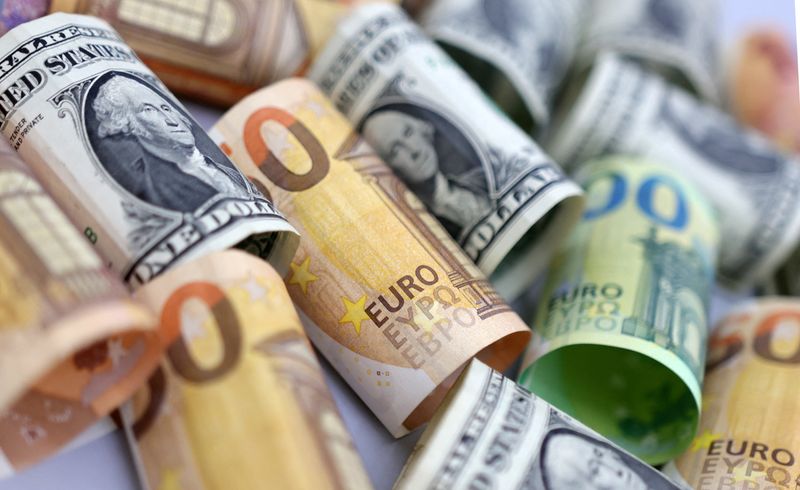Written by Amanda Cooper and Tom Westbrook
LONDON/SINGAPORE (Reuters) – The U.S. dollar maintained its strength on Tuesday as the market anticipates a gradual decrease in interest rates by the Federal Reserve next year. Traders believe that while a cut is expected, it will be implemented slowly.
In contrast, the pound was one of the few currencies to appreciate against the dollar after recent data indicated a stronger-than-anticipated growth in British wages for the three months leading up to October, suggesting UK rates may remain higher for a longer period compared to other regions.
The Federal Reserve is set to announce its interest rate decision on Wednesday, with futures indicating a 94% probability of a cut. This comes even as the services sector experiences significant growth, reaching a three-year high in an S&P Global purchasing managers survey.
The Atlanta Fed’s GDPNow indicator estimates a 3.3% growth rate for the fourth quarter, boosting U.S. yields and supporting the dollar as traders reassess the neutral rate for the economy, which seems to be higher than previously projected.
“We expect the Fed to adopt a more cautious stance regarding the future of rate cuts. A 25 basis point cut this week is almost certain, but the crucial question pertains to next year’s plans,” noted Lee Hardman, a currency strategist at MUFG.
“We believe there is a substantial chance the Fed will choose to hold rates steady at its next meeting in January,” he added.
With U.S. President-elect Donald Trump assuming office in January, he has already committed to several initiatives, such as imposing tariffs on imports from countries like China, Canada, and Mexico, and also plans to deport millions of undocumented migrants. These actions could potentially lead to a prolonged rise in inflation, which may hinder the Fed’s ability to lower rates significantly.
In September, Fed officials projected a median long-run interest rate of 2.9%. Current market expectations suggest virtually no likelihood of rates reaching that level by December of next year, with only a 30% chance of falling below 3.75% by the end of 2025.
The euro, which is trending toward a nearly 5% decline against the dollar this year, slipped 0.2% to $1.04823.
German yields, which serve as a benchmark for the eurozone, have risen by approximately 20 basis points this year compared to about 55 basis points for U.S. Treasuries, reflecting a belief that U.S. rates will decline more slowly than their European counterparts.
The spread between U.S. and German 10-year yields has widened to 216 basis points, near a five-year peak, having increased by nearly 70 basis points over the past three months.
UPCOMING RATE DECISIONS
Trading activity across the currency markets remained relatively subdued on Tuesday as traders paused in anticipation of the Fed’s announcement, along with policy decisions from the Bank of Japan, Bank of England, and Norges Bank on Thursday, all of which are expected to maintain their current rates. Sweden’s Riksbank is also expected to reduce rates, potentially by half a point.
The pound gained on Tuesday following data revealing that regular pay in the UK surged faster than expected during the three months leading to October.
The Bank of England has often highlighted wage growth as a key reason for its cautious stance on rate cuts. A recent survey of business activity in the UK also indicated increasing inflationary pressures.
The pound was last up 0.1% at $1.2696.
Meanwhile, the Canadian dollar struggled, trading at 4.5-year lows near C$1.4277 against the U.S. dollar. The recent resignation of Finance Minister Chrystia Freeland has further complicated matters for an already unpopular government amid diminishing interest rates and potential U.S. tariffs.
The yen appreciated slightly, leading the dollar to decline by 0.15% to 153.89 yen after six consecutive days of selling, as markets adjusted their expectations for a Japanese rate hike this week in favor of a potential move in January.
The Australian and New Zealand dollars remained close to their annual lows, with the former down 0.41% at $0.6345, and the latter down 0.39% at $0.576. New Zealand has revised its bond issuance forecast upwards for the coming years.
The currency was stable at 7.2892 per dollar as pessimistic forecasts surrounding Chinese economic growth kept 10-year bond yields near historic lows.
Last week, Chinese leaders agreed to raise the budget deficit to a record 4% of GDP for the following year, while maintaining an economic growth target of approximately 5%, according to sources familiar with the situation.






